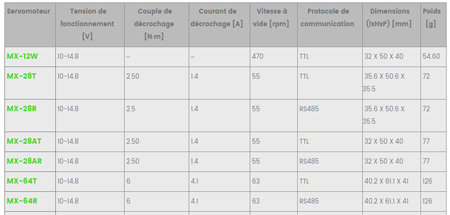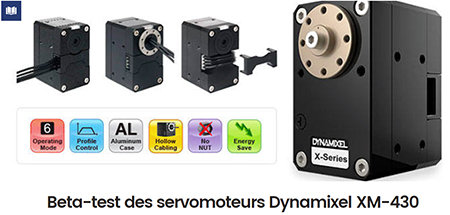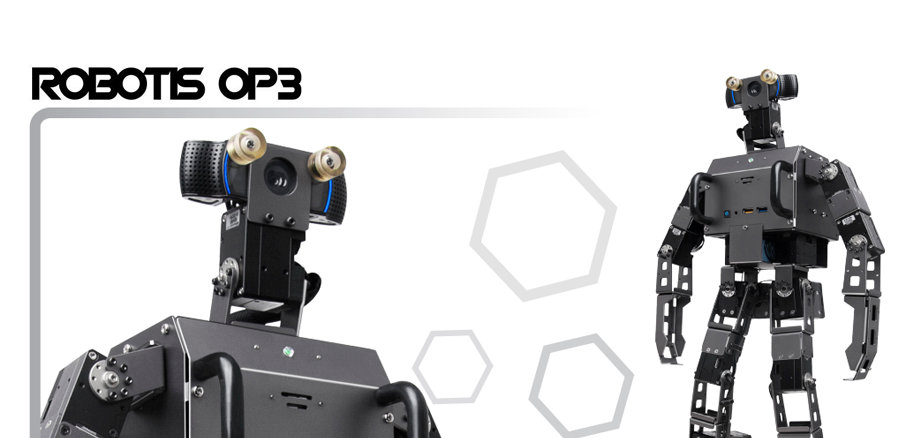Robotis OP3: a highly versatile medium-sized humanoid robot Robotis OP3 is a reasonably priced, ROS-compatible humanoid robot equipped with a more powerful computer than many of its competitors.
Presentation of Robotis OP3
The Robotis OP3 humanoid robot, with its embedded Intel NUC PC, is the most recent addition to the DARwIn series of humanoid robots developed by Korean manufacturer ROBOTIS.
Its default OS is Linux, and it can also operate under 32-bit and 64-bit Windows, unlike its predecessors which worked only with 32-bit Windows. Its dual-core I3 processor, supported by 8 GB of DDR4 RAM and a 128 GB SSD disk, give it a computing power that its predecessors could only dream of.
This means an Open CR sub-controller can be used to manage the robot’s 20 XM430 actuators, offering 20 degrees of freedom. These XM430s have a higher rotational power than the MX-28s used in the previous-generation DARwIn OP2, enabling more complicated actions.
 |
 |
| Comparative table of Dynamixel servos | Dynamixel XM-430 servo test |
A new HDMI connector has replaced the mini HDMI and there is a new Bluetooth module, making connecting to the Robotis OP3 that much simpler. Robotis OP3 can analyse and interact with its environment thanks to a Logitech C920 Full HD camera and IR sensors, and with users via speakers and a microphone.
Its 3-axis gyroscope and 3-axis accelerometer also make it capable of dealing effectively with unforeseen events. It is ROS compatible through Kinetic on Ubuntu Xenial and comes with a complete set of documentation, available on ROS Wiki and in the form of e-manuals for the Dynamixel servos and the robot itself. All this documentation is listed at the dedicated GitHub.
What can the Robotis OP3 robot do?
Thanks to a new, more powerful algorithm and a Full HD camera, vision processing has improved and is more precise. The robot can easily perform face tracking operations and distinguish between colours and shapes.
It has 20 servos, 12 of which are located in the lower part of its body, allowing more precise motion, even on slopes. Not only can you program its movements and reactions, but its ROS compatibility allows you to also control it manually.
What can I use my Robotis OP3 humanoid robot for?
Its two control methods make this robot an interesting choice in a variety of fields, in particular:
- Education, to teach coding, control and interaction with robotics
- Research, thanks to its various sensors and camera
This robot can access hard-to-reach places and its 3-axis magnetometer can record numerous data. Its equipment allows users to not only conduct AI research, but also overcome potential problems and weaknesses in full-size robots.
For example, a small humanoid robot was recently used to study motor acceleration times, a parameter than can prove problematic in high-precision areas. Another study has been carried out on a small humanoid robot to analyse power spikes when switching on motors, an important factor when determining a robot’s power supply.
How does Robotis OP3 compare to other similarly sized humanoid robots on the market?
For a reasonable price, you get a robot equipped with a more powerful computer than many of its competitors. Like the DARwIn OP2 robot, which is its predecessor, Robotis OP3 is open source, which isn’t always the case for other robots in the same category, including the NAO robot.
In addition, it’s one of just a few platforms to combine this feature with Windows x32/x64 and Linux x32/x64 compatibility. It is therefore a complete and very versatile robot that will satisfy a wide range of requirements.

